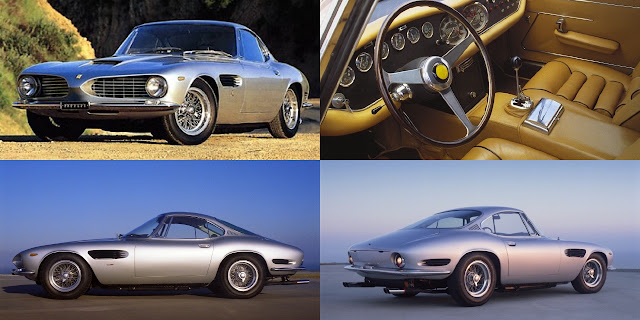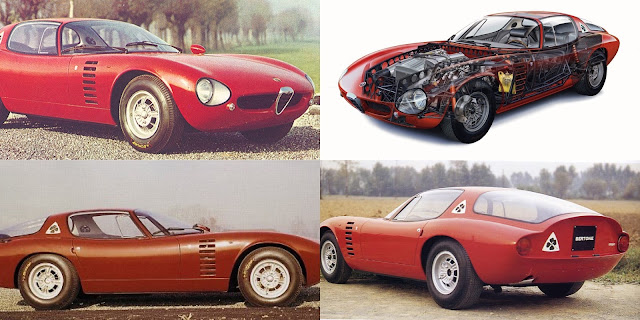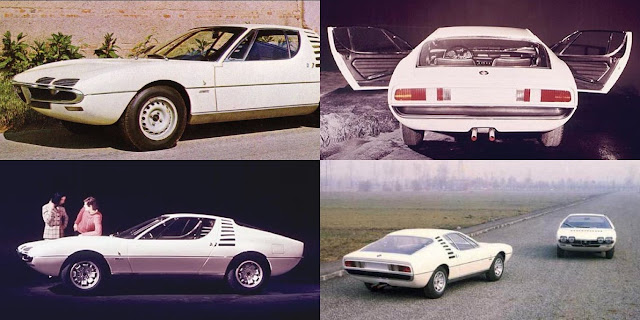What has long fascinated me about cars is their designs. And Gruppo Bertone was one of the first of the big coachbuilders to suck me into the world of design, and also one of the factors that made me pursue a Bachelors of Architecture, dreaming that one day, I could too, influence a whole generation the same way Gruppo Bertone influenced me.
Though the 70’s was really when futuristic Italian design came into play with the Countach and Carabo, we have to start at the beginning of the 60’s: The foundation and what Bertone did to evolve from the voluptuous shapes of the 50’s to the wacky wedges and brilliant boxes of the 70’s
Going in chronological order, we start with the year:
1960:
1. Ferrari 250 GT Prototype Enrico Wax
2.Gordon-Keeble GT
1961:
1. ASA 1000 GT
2. Aston Martin DB4 GT Jet
I’d say that this, probably, is Aston Martin’s most famous coachbuilt car of the 60’s: true Italian styling on a British shape! The shell was built on the highest DB4 GT chassis number (0201L) out of steel instead of aluminium, which made it slightly heavier than the standard cars, despite its sleeker shape. This car was one of 2 Aston Martin’s Giorgetto Giugiaro designed, the latter being the Twenty-Twenty, debuting exactly 40 years after the Jet.
3. BMW 3200 CS
4. Ferrari 250 GT Bertone
This Ferrari would be the second and last Ferrari that Nuccio Bertone himself would design, and was really meant as a car for himself, so it was a one-off. You may think that the split-nose design of the front was quite odd for Italian standards, and maybe belonged on an American car like a Plymouth or Pontiac, but Bertone actually intended the design to be a tribute to the Ferrari 156 F1 Formula 1 race car’s ‘shark-nose’. The side profile was well received and Ferrari changed their future models to follow suit with this sort of design.
5. Maserati 5000 GT Coupe
Built on the platform of the existing 3500 GT Coupe, the new 5000 GT featured a larger 5.0L V8 and was used more as a coachbuilt, ‘custom-made’ car. 34 cars were distributed to multiple coachbuilders to design their own versions of the 5000 GT. Most of the cars were designed by Allemano, which was quite subtle compared to the others. Carrozzeria Touring designed 3, Frua had 3, Monterosa 2, while Pininfarina, Ghia, MIchelotti and Gruppo Bertone each designed 1.
1962:
1. Iso Rivolta GT
Although the name sounds ‘revolting’, the car itself wasn’t. The chassis was designed by the very famous Giotto Bizzarrini and styling was done by the equally famous man of many G’s, Giorgetto Giugiaro. It’s angry eyes were reminiscent of the Gordon-Keeble GT of 1960 and gave the car a more aggressive look. It wasn’t all for show though, 799 of these were made, and all of them were powered by 327 cu.in. Chevrolet Corvette engines.
2. Simca 1000/1200S Coupe
The first French car on this list and one that I’ve actually seen in person. How I’d describe the car is the looks of a Fiat 850 Coupe with the shape of a Matra Djet/Alpine A110 Berlinette. It wasn’t all that popular with the press however, as its performance didn’t live up to its racey styling, and because of its wraparound bumpers and complex design, it was also more expensive to make. Because of this, the Coupe did not have a direct successor after, instead having a belated return in the form of the 1973 Matra Bagheera, a decade later.
1963:
1. Alfa Romeo 2600 Sprint HS
This Alfa Romeo was a clear indicator of the changing times. While the body of the car remained a banana-esque profile, with the cockpit of the car, centered in the middle, the front of the vehicle sloped into a sharp wedge, possibly to invoke the aerodynamic looks of race cars of the same era. The world probably wasn’t ready for this drastic design change, and so Bertone kept the car solely as a one-off.
2. Chevrolet Corvair Testudo
I would say the Chevy was the start of Bertone’s emergence as the design house that everyone thinks about when thinking about “wedge cars” and the “more unique looking concepts of the 60’s-70’s” The car was very much following in the lines of American Atompunk, with a rounded UFO-like profile and a bubble canopy with wraparound glass that opened as a whole door. At the time, the Corvair was considered the American Porsche, and you can kind of see it in this car with those slanted headlights and it was also powered by an air-cooled Boxer 6!
3. Iso Grifo
1964:
1. Alfa Romeo Canguro
Following the great reception the Corvair Testudo from 1963 got, Bertone decided to ramp up its wackiness and create the Canguro. It’s a mix of crazy voluptuous shapes and a big bubble-shaped cockpit, similar to that of the Corvair. This design would be so well received that Alfa Romeo would later base all of its TZ cars after this curvaceous car!
1965:
1. Fiat 850 Spider
The Miura before the Miura. In fact, the Lamborghini reused the same headlights as this little Fiat, as they were in the Bertone parts bin! The headlights that tilted were also an idea that this little Fiat had as well, which was originally inspired by the aforementioned Corvair Testudo. Other than that, the little car looks simple, and that was best for the lower end of the market in which this car was aimed at.
2. Ford Mustang
The 1965 Mustang is great and all, but when you dip it in a little of that Italian sauce, the outcome is sure to be spectacular. In fact, this mustang was so beautiful, Ford decided not to make it the production version, scared that they couldn’t make a successor of this already perfect design. (The most probable reason was probably because it looked a little too elegant for what it was aimed to be.)
1966:
1. Jaguar FT Coupe
2. Lamborghini Miura
The late 60’s was when Gruppo Bertone really started to shine on the global stage. I’m sure everyone has seen and heard of this famous Lamborghini. Many people consider the Lamborghini Miura to be the first true supercar, with its flowing accentuated lines, seductive eyelashes, and complemented by the famous V12 which powered all 12-cylinder Lamborghini’s all the way through to the Murcielago.
3. Porsche 911 Roadster
From the outset, this looked neither German, nor like anything Porsche would ever design. In fact, it looked a lot more like a Fiat 850 Spider with actual hidden headlamps with bumper designs from, again, the Chevrolet Corvair Testudo. It also was heavily influenced by a lot of Bertone’s designs, having the one-piece wraparound bumpers, creating a seamless, flowing design, but also an excessively expensive and complex way to manufacture the car.
1967:
1. Alfa Romeo Montreal Expo Prototipo
I love retro concept cars. They aren’t exaggerated too far from the production cars. This one for example is very very close to the Montreal road car. The main differences being the headlight covers which changed to revolving covers, the horizontal slat vents across the bonnet changed to a single NACA duct and 7 side slats changed to just 6.
2. Fiat 125 Executive
3. Jaguar Pirana
Proposed to be the new shape for the Jaguar E-Type 2+2, the shape was probably too radical and different to the bulbous shape of the classic E-Type, so the Pirana never reached the production phase. But as retro concepts go, those that are refused or unused, go on to other brands, this one becoming the Lamborghini Espada in the next year.
4. Lamborghini Marzal
1968:
1. Alfa Romeo Carabo
2. Bertone Panther
3.Lamborghini Espada
As mentioned before, the Espada was the child of the Jaguar Pirana and Lamborghini Marzal, and with it’s wedge shape, it was very well received by the press, even to this day, where it is still regarded as one of Lamborghini’s best designed front engined cars! With the Miura and now the Espada, Bertone became the standard design house to Lamborghini, just as Pininfarina was to Ferrari!
4. Lamborghini Miura Roadster
The Lamborghini train doesn’t stop there, ‘68 saw the birth of the topless Miura, made as a one-off and having the same colour spec as the very first Lamborghini 350 GTV (Magnolia Leather on Metallic Blue), which was designed by the lesser known Carrozzeria Sargiotto. The car still featured the same design as the standard Miura, but it had the steering wheels from the prototype Espada and had no rear windshield, instead opting for some black side haunch accents, which would later be implemented on the Silhouette, Jalpa and other Lamborghini’s to come. A second Roadster was produced in 1969, but was done aftermarket, by modifying an existing Miura, painted it a Metallic Green with a tan interior, and all the black trim was redone into chrome.
1969:
1. Autobianchi Runabout
Drawn heavily from powerboats at the time, this wedge-shaped ‘Runabout’ became the basis for the Fiat X1/9 that came a few years later. The engine was taken from the Fiat 128 (under the Autobianchi marque) and was mounted in the middle of the car. The most iconic feature of this wacky concept was that the headlights were mounted behind the occupants of the car, on the roll bar. This, combined with its striking red and white paint job, solidified this proposal in the Concept Car Hall of Fame.
2. BMW 2800 Spicup
I’ve said this before, and I’ll say it again. Green is the perfect colour for any car! And as a ‘green fiend’, when I first discovered this car, not only did it become one of my favourite concept cars, but also my favourite BMW! The name ‘Spicup’ is actually an amalgamation of Spider and Coupe, and the car is both of those. The roof automatically closes and opens by retracting out of the wing-like structure on top of the B-pillar. As if the outside wasn’t green enough, the interior was cast in a duo-tone dark forest green over a lime splash of colour! This complemented by the chrome trim and orange front indicators made this Spicup feel like a continuation of the Carabo’s design!
3. Fiat 128 Coupe
4. Iso Lele
With these 28 cars Gruppo Bertone designed over the decade from 1960-1969, you can truly understand the design house's unique lines and evolution, and how they affected many of what we know today to be the 70’s wedge cars. Out of these, which one is your favourite? And which design house or decade would you like me to document next? Pininfarina? Zagato? The 1970’s? Please comment below!































No comments:
Post a Comment